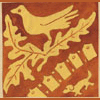
The Collections:
• Parker-Hore

|
TileWeb: Paving-tile Watercolours Online |
The Collections: |
| The Parker-Hore Archive Collection of Watercolours of Paving-tiles | ||
| held in Worcester and in the Ashmolean Museum, Oxford |
|
|
The study of architectural ceramics |
|
||
|
Manufacture and location Initially the designers of the great pavements in England may have been trained as metalworkers, employed at court. During the thirteenth century a new craftworker emerged in England, Wales and Scotland - the tiler. Most of the evidence for the making of medieval tiles comes from archaeological sources, tilers are rarely mentioned in historic documents. Medieval paving tilers, like their fellow craftsmen, the potters, required clay and a supply of sand, water and fuel - usually peat, brushwood or loppings from the lower branches of trees from the King's great medieval forests. Mrs Irene Hore was interested in the processes of manufacture, she measured tiles and recorded the thickness of the tiles, but the technical processes are not set out in the archive. Early relief and counter relief tiles are described in East Anglia and the north west of England but it is not possible to establish whether the decorative motifs on the two colour tiles were inlaid or `printed'. The use of inlaid decoration was without precedent in antiquity. |
||||
| Image: Man at work, perhaps a tiler digging clay | ||||
| Back to the Study of Architectual Ceramics | to ... Dating | |||
| TileWeb Home Page | ||||
|
© Copyright of this digital resource will be held jointly by last updated: jcm/7-jun-2004 |
 |
 |